|
Clyno
Motorcycles
Clyno was founded in 1909 by two cousins, Frank and
Ailwyn Smith, at Thrapston, Northamptonshire, to produce a
variable speed drive for motorcycles, using a pulley with
inclined faces. The Clyno name is derived from the word
'inclined'.
The first part is a
history of the company from 1909 to 1916 that was written by
Ailwyn Smith. |
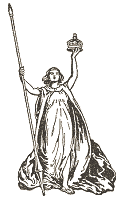 |
1909
During 1909 two cousins A. P. Smith and F. W. A Smith, sons of two
directors of the family business Messrs Smith and Grace Ltd.,
Transmission of Power Specialists and Iron Founders, Thrapston,
Northants, formed as a partnership, The Clyno Engineering Co., for the
purpose of marketing an adjustable belt pulley for Motor Cycles. |
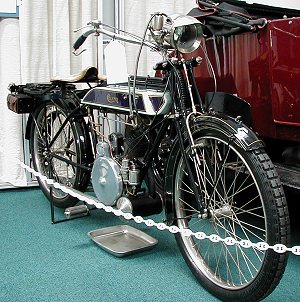
A Clyno machine from collection at the Black Country Living
Museum, Dudley. |
They rented a small workshop in Thrapston at 5/-
per week and first worked at the business part time only. The
pulley, adjustable by means of two inclined cam faces, one on
the adjustable flange and the other on the adjusting collar,
filled a need amongst motor cyclists and sufficient orders were
soon received to necessitate the partners devoting their whole
time to the business and eventually obtaining extra help.
The
pulleys sold at 12/6d each, bored to suit any make of Motor
Cycle engine. A point was made of invariably dispatching orders
the same day as received.
The plant employed in these early days
a 6.5inch centre lathe, a small sensitive drilling machine, and
a key slotter, converted from a carpenter's tenon machine. This
plant was driven by a very old Crossley 2.5h.p. gas engine.
Electric light, generated by a dynamo driven by the engine
installed. |
1910
Early in this year the partners thoughts turned to the
manufacture of complete Motor Cycles and a prototype was duly
built, using Chater Lea frame fittings and Stevens engines, made
by the Stevens Motor Manufacturing Company Limited, Wolverhampton.
It
was a belt driven 350c.c. machine of simple construction. A few
of these were sold locally. In these early days
successful participation in Motor Cycle Trials was felt to be
the best method of advertising. |

A close up of the engine in the machine
above. |
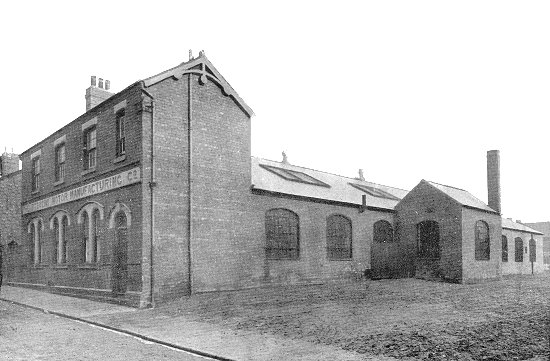
Clyno's original factory in Pelham Street, Wolverhampton.
|
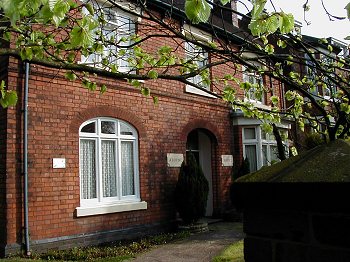
Ailwyn Smith's home, Aboyne House,
Merridale Rd. |
This first machine was entered and ridden by Frank
Smith in the A.C.U. quarterly non-stop trials with repeated
success.
About this time a motor cycle stand was patented, this
consisting of telescopic tubes, independently adjustable so that
on uneven ground the machine would stand upright.
The stand did
not sell in large quantities and with the advent of the side car
combination was abandoned. |
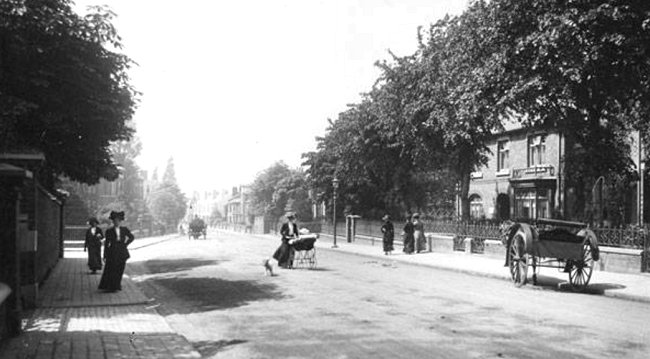
How Aboyne House would have looked in Ailwyn's
day.
| The first Clyno 2.75hp. machine,
built at Thrapston, and displayed at the 1909 Stanley Motor
Cycle Show. Courtesy of Chris
Smith. |
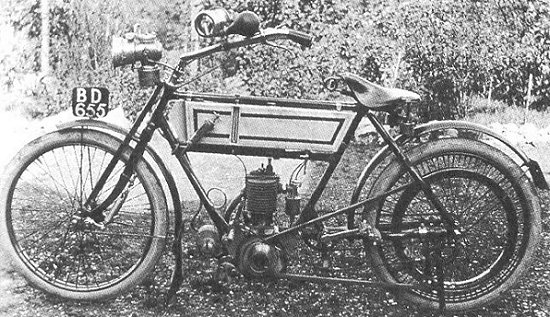 |
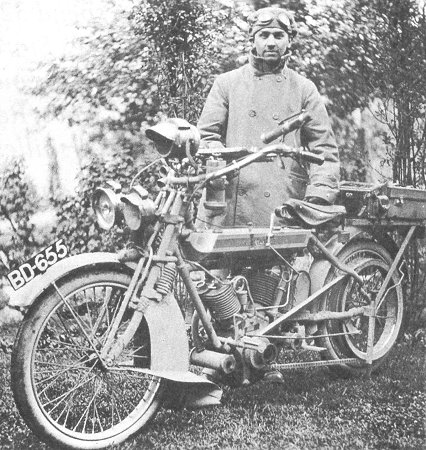
Frank Smith and his
6hp. Clyno V-twin in readiness for the 1910 M.C.C. London-Edinburgh trial. Courtesy of Chris Smith. |
Later in 1910 a more powerful machine was built
utilising the 5/6h.p. V-twin Stevens Engine, mounted in
a long, low (for those days) frame. This machine was run in the
quarterly trials, also in the M.C.C. London-Edinburgh and
London-Exeter trials.
Its low build, light weight (under 200
lbs) large engine and high gear ratio made it a very pleasant
machine to handle. It was the forerunner of the very successful
sidecar machine of later years, even in its belt driven form it
was capable of a good performance with a sidecar.
Meantime the orders placed with the Stevens Motor manufacturing
Company, resulted in a visit of their representative to Thrapston,
this visit being the prelude to negotiations for the purchase of
the Stevens concern, which was in Voluntary liquidation. |
| This purchase was eventually
completed and on 15th October 1910 the business was transferred
from Thrapston to Wolverhampton, and for a time was carried on
under the names of The Clyno Engineering Company, and The
Stevens Manufacturing Company, but the latter name was soon dropped.
The firm exhibited for the first time at the 1910
Motor Cycle Show at Olympia, showing Motor Cycles,
Adjustable pulleys and Telescopic stands. |
 |
Clyno's original factory in Wolverhampton,
as seen in 2012. Behind the
offices was the spares department, under Mr. Heckford. |
1911
The limitation of a single fixed gear and belt drive were apparent in
1910, and with the increased manufacturing facilities at Wolverhampton,
a two speed, chain driven machine was evolved and it is thought to be
the first to enclose chains in pressed aluminium cases. It was this machine
that Frank Smith drove so successfully in all the important
trials in 1911, he also embarked on a programme of attacking
hitherto unclimbed and what were considered unclimbable hills,
all with the 5/6h.p. chain driven Motor Cycle and
sidecar.
Notable hills successfully climbed were Porlock and the
North Devon terrors, Honister as well as many other Lake
District hills etc., etc.
The question of a suitable sidecar
frame was given careful attention, hitherto sidecar frames were
very light flimsy affairs, clipped to the Motor Cycle frame,
generally in three places, they were quite
unsuited to strenuous trials and other use. A very robust
sidecar frame, attached to the Motor Cycle in four places by
taper plugs secured into appropriate sockets, solidly brazed to
the Motor Cycle frame, was made, this design remained virtually
unaltered for many years. It was imitated by all and sundry. |
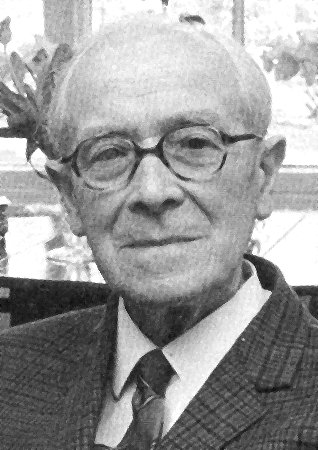
The late Ailwyn Smith. Courtesy
of Chris Smith. |
| 1912
The success of the
1911 trials policy had its effect in 1912 which was a very busy
year, orders in excess of the manufacturing capacity being
received.
During this year the Clyno Motor
Cycle Detachable and Interchangeable wheel was introduced and
fitted, this invention first fitted to Clyno Machines, was one
of the most important developments in Motor cycling history.
|

The 1912 6hp. V-twin.
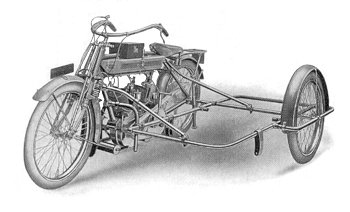 |
In 1912, the company sold a
version of its sidecar machine for use as a commercial delivery
van.
The basic price of the machine was £81.10s.0d, the body was
extra and designed according to individual purchaser's
requirements.
The motorcycle could deliver 5-6hp. and sales of
the product were very high. |
| Opposite the offices of the Company
in Pelham Street
was the old Wolverhampton Humber Cycle factory, long
since unoccupied, and negotiations for its purchase were
started, these works were eventually taken over and laid out for
the manufacture of frames and the assembly of completed motor
cycles and sidecars. Engine and gear box manufacture continued in the original factory
across the road in Pelham Street. |
|
Clyno cars leaving Ashes Works and
entering Pelham Street. Ashes Works were previously occupied by
the Humber Cycle Company.
Photo courtesy of the late Geoff Stevens.
|
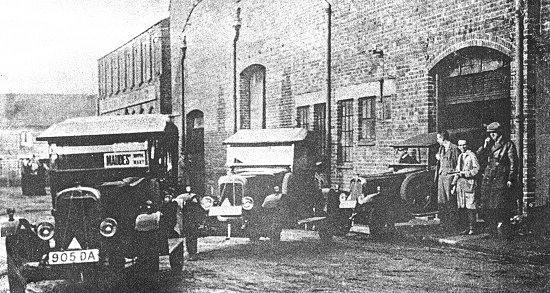 |
 |
Ashes Works in Pelham Street, in 2012. Taken
from the same position as in the previous photograph. |
| Another view of Ashes Works,
which were also called Tower Works.
Part of the factory was destroyed in a fire
many years ago. The whole factory
has since been demolished.
|
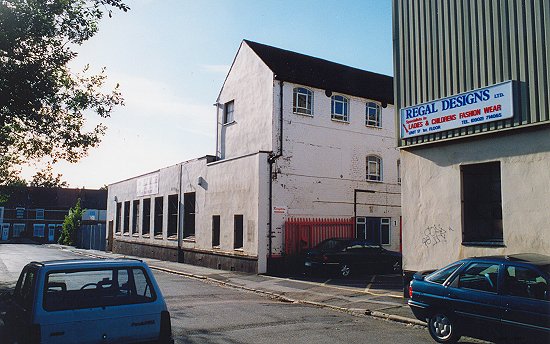 |
| The factory was considerably
extended and the whole of the available ground space occupied by
work shops.
The policy of running in all important trials, not only
in Britain, but also abroad, was persisted in, with marked
success.
View the 1912
catalogue |
 |
| |
|
|
1913
Mr. W. Comery joined the firm as Chief Designer and
immediately set about redesigning the machine using basically the same
5/6h.p. engine but substituting a 3 speed gear box and an entirely new
frame. This machine was very successful and easily held its own against
increasing competition. |

The 1913 V-twin.
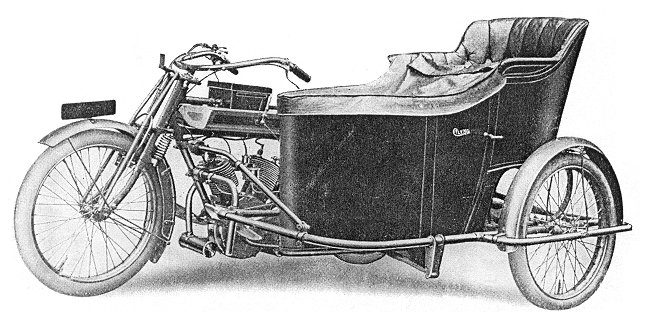
The 1913 combination.
 |
The running of machines in trials was intensified
and well known drivers with considerable trials experience
joined the staff, Hugh Gibson and Archie Cocks being amongst
them.
Two young works testers, C.V. Freeman (actually the first
employee of the company) and L. R. Pearson, both having great
success in many trials.
Rev. P. W. Bishoff and his wife also
participated privately in a number of trials using Clyno
outfits. Financial difficulties were not nonexistent during
1913. |
| Development was rapid and inclined to outstrip the financial
resources of the company, which was still a private partnership. Later
in 1913 it was decided to fill an obvious need for a light, simple and
cheap solo Motor Cycle, and a 250c.c single cylinder, 2 stroke machine
was designed.
This machine had a 2 speed gear and belt drive, and was
novel, in that the engine and gear box were of unit construction, chains
being entirely absent.
It was one of the first machines to be sold
completely equipped with lamps, horn and number plates, ready for the
road at an all in price. This was exhibited at the 1913 Motor Cycle
show, being very successful and sold in large numbers. |
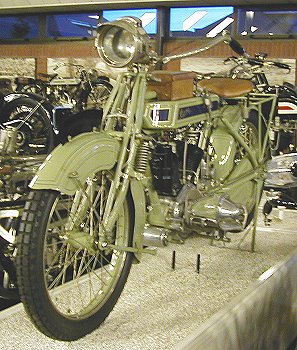
The Clyno 750c.c. machine, built in 1914,
that is on display at the National Motorcycle Museum,
Birmingham. |
| |
| An article from 'The Motorcycle', 6th
November, 1913:
The Latest Clyno
Pear-shaped
cylinder, improved lubrication, and new design
sidecar.
The Clyno Engineering
Company have obtained a reputation second to
none for their sidecar models, and next year the
added refinements will keep this machine in the
forefront for passenger work.
The main alterations in the
engine which is a 50 degree twin-cylinder, 76
mm. by 82 mm. bore and stroke, giving a capacity
of 744 cc., is the casting of the cylinders
pear-shaped for next year's machines, for the
purpose of more perfect radiation. It also has
the advantage of giving a very neat-looking
cylinder. An alteration has been made in the
design of the crankcase, whereby an equal supply
of oil is assured to both cylinders. The neat
valve stem covers are retained. A new pattern of
front chain case has been, adopted, and the foot
brake has been improved in detail.
An excellent feature is the
provision of large fuel tanks; two and a quarter
gallons of petrol can now be carried.

The 1914 5 - 6 hp. Clyno. Observe
the new type sidecar, method of
carrying spare wheel, kick starter,
change speed gear, and footboard. |
The
Detachable Wheel
Of course, the detachable
wheels to both machine and sidecar are retained,
and probably no feature has gained such
universal popularity among riders. It is
literally but a moment's, job to take out and
replace any of the three wheels, the spare being
carried on a dummy hub on the sidecar rear
panel. A slight reduction has been made in the
total weight of the machine. A minor improvement
is the use of inverted levers for front brake
and exhaust lifter control. The three-speed car
type counter-shaft gear box is a really fine
piece of work, with its six-splined mainshaft.
The whole box is mounted with great rigidity,
and the transmission is particularly sweet as a
result. The ratios provided are 5, 9, and 15 to
1. On the top of the gearbox the magneto is
fitted, driven by an enclosed chain, easy
adjustment being afforded by sliding the
magneto.
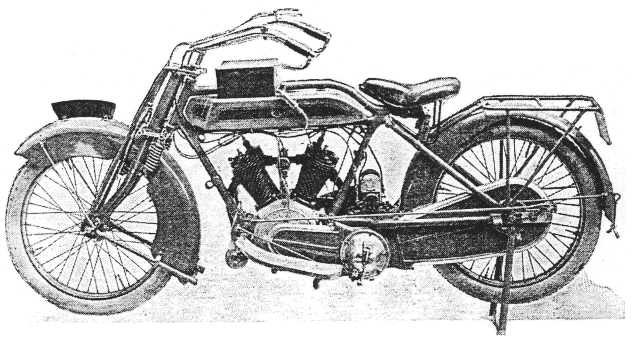
Showing the clean lines of the
1914 Clyno. It will be noticed that
the radiating fins extend the whole
length of the cylinder. |
The New
Sidecar
Comfort, combined with a
handsome appearance, is the keynote of the very
fine sidecar for 1914. As already stated, the
wheel is of the Clyno patent detachable type,
and the spare is neatly mounted on the rear
panel on a dummy hub, and supported by a
bracket. A complete measure of protection is
provided for the passenger by a really well
fitted hood with side curtains and an adjustable
screen. When all is "storm rigged," the occupant
is almost as well protected as if in a car. An
attractive panel of cane work runs along the
sides of the coachwork. The design of the
sidecar body is a new one for the Clyo firm, and
is; we think, an improvement as regards
appearance on the 1913 models. Altogether, these
passenger outfits are among the finest to be met
with on the road, and their wonderfully
successful appearances in the big trials prove
them to be as reliable as they are handsome. |
|
|
| |
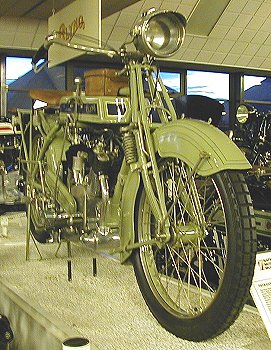
Another view of the Clyno 750c.c. machine, built in 1914,
that is on display at the National Motorcycle Museum,
Birmingham. |
1914
The machines marketed in 1913 were continued with
minor modifications. Several models of the sidecar bodies
were standardised and the running of trials continued.
The end of the summer brought the first World war, which
in view of the financial embarrassment mentioned earlier
was a blow to the concern. The death of Mr. N. Smith, father of
A. P. Smith in November 1914, increased these difficulties, as
Mr.
Smith was one of the guarantors.
1915
After an anxious time early in the year, the issuing of War
Contracts relieved the situation somewhat, and the manufacture
of a Motor Cycle combination with machine gun attached was
developed in conjunction with Messrs. Vickers Ltd.
It was known
as the Vickers-Clyno machine gun motor cycle outfit, and
together with the ancillary motor cycle machine gun ammunition
carriers, were manufactured in large numbers. |
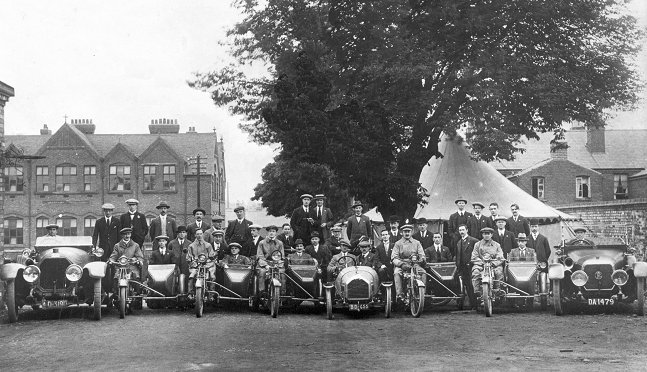
The Clyno Staff outing to
Stourport in 1915. The photograph is taken behind the Pelham
Street works, looking towards Great Brickkiln Street.
The
building on the left used to be a school, but is now a social
club. Frank Smith is on the extreme left in a Peugeot, and Ailwyn is on the extreme right in a Panhard. Photo courtesy of
the late Jim Boulton. |
1916
The product of the factory was still primarily the machine
gun outfits, together with a number of the two stroke solo motor cycles
for Army use.During the early part of the year the hitherto
successful partnership showed signs of strain and the question of a
dissolution could not be ignored.
Eventually this course was decided
upon, A. P. Smith retiring from the business, leaving Frank Smith in
charge.
A. P. Smith relinquished any active part in the running of the
business as from June 1916.
Dissolution agreement was
reached 4th July 1916 and the partnership was officially dissolved as
from 30th September 1916 by an indenture dated 4th October 1917. |

The Clyno First World War motorcycle
machine gun carrier at the National Motorcycle Museum. |
Below is a list of some of
the Clyno employees:
| W. Comery |
Chief Designer |
| S.C. Poole |
Assistant |
| J.M. Wylie |
Buyer |
| C. Franklin |
Records |
| H. Gibson |
Sales and Trial rider |
| C. H. Crole-Rees |
Sales Manager |
| A. Cocks |
Sales and Trial rider |
| F. Lloyd Parton |
Commercial Manager |
| Florence Gould |
Chief Clerk |
| H. Meadows |
Works Manager |
| H. Wiggett |
Machine shop Superintendent |
| J. H. Gould |
Assembly and Fitting
Superintendent |
| G. E. Newey |
Machine Shop Foreman |
| A. F. Knight |
Sales |
| I would like to thank
Chris Smith, Ailwyn's grandson for allowing us to include this important
document from his family archive. After leaving the company in
1916, Ailwyn Smith went on to pursue a highly successful
career with Samuel Taylor & Sons of Brierley Hill where he
designed staircases for the side of ships, chains and
anchors etc.
The First World War and
later
During the First World War, Clyno signed an agreement
with the Russian War Commission at the Savoy Hotel in London
for the supply of solo and combination machines for the
Imperial Russian Army. During the war large numbers of heavy
motorcycle combinations were produced for both the British
and Russian armies. They consisted of mobile machine gun
units, ammunition carriers and solo machines. During 1918
and 1919 Clyno also built a number of ABC Dragonfly aero
engines.
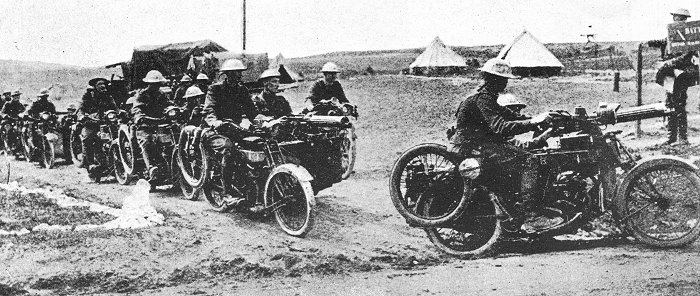
A Clyno machine gun battery, leaving
camp.
Mr. Heckford, Clyno's Service Manager remembered being
'roped-in' as a road tester for the Clyno machine gun
carriers, when they were ridden in convoys of 20 or 25 at a
time to Kempton Park, which continued for several months.
The machine gun was mounted on a tripod that could easily be
removed from the chassis. The wheels were detachable and
interchangeable. A spare wheel was carried beside the
pillion seat.
The Dragonfly had nine cylinders, weighed only 600lb, and
could deliver 365hp. Early in 1918, Clyno received an order
for 8 prototype engines and 500 production engines. Work on
the engines quickly got under way and the first engine was
delivered on 22nd April 1918, followed by another in June.
By the end of the year, 6 of the prototype engines and 4 of
the production engines had been completed. The final two
prototypes were delivered early in 1919, along with 47
production engines. The other 453 were cancelled. The orders
came too late in the day, because the war soon ended, and
the Ministry cancelled all outstanding items. |
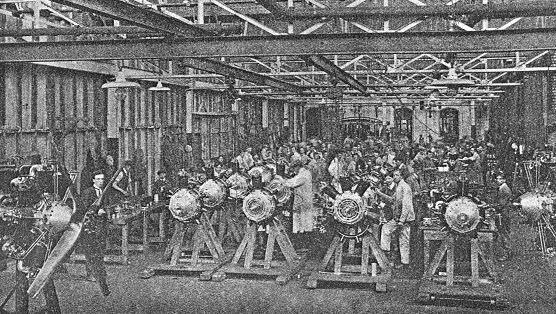 |
Assembling ABC Dragonfly engines,
during the First World
War. Courtesy of the late
Jim Boulton. |
| After the war it seemed that the Clyno Engineering
Company would have a bright future.
A new motorcycle, the highly acclaimed 'Spring 8' with a
top speed of 50m.p.h. was launched in 1919 at the Olympia
show. Unfortunately it would be two years before the machine
went into production.
In 1920 the post-war motorcycle market collapsed, and the
original works manager Henry Meadows, left to form the well
known engine manufacturing company, Henry Meadows Limited at
Fallings Park. |
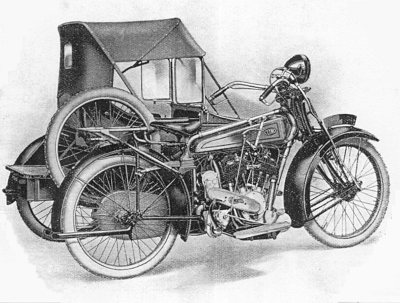
The Clyno 'Spring 8' 8h.p. de Luxe
Combination. From an advert. |
|
At the time, large numbers of cheap ex-W.D. machines were available. To
compound the problem, there were also shortages of materials, which
didn’t help production, and last but not least, the Russians failed to
pay for the military motorcycles they had received during the war. As a
result the company's financial backers withdrew, and the Clyno
Engineering Company went into liquidation.
Rebirth
Frank Smith very much wanted to produce cars, and with this in mind he
formed the Clyno Engineering Company (1922) Limited with a capital of
£100,000. Frank’s father, William Smith was chairman, and Frank became
managing director. Initially both cars and motorcycles were produced,
but by the autumn of 1923 motorcycle production had ended. The new
company stated that no Clyno machines would be displayed at the 1923
Motor Cycle Show.

Chris Smith (Ailwyn's grandson) and a Clyno motorcycle.
|
Many of
the motorcycles were designed by Arthur G. Booth.
Read a paper that was given by him and view some of his Clyno
photographs |

|
|